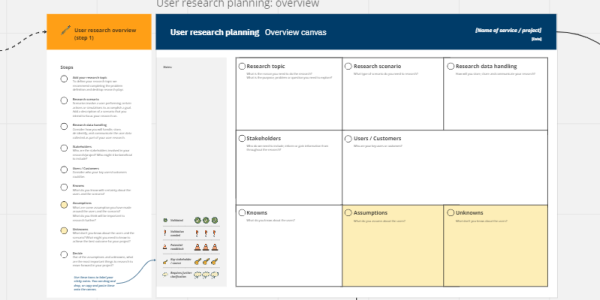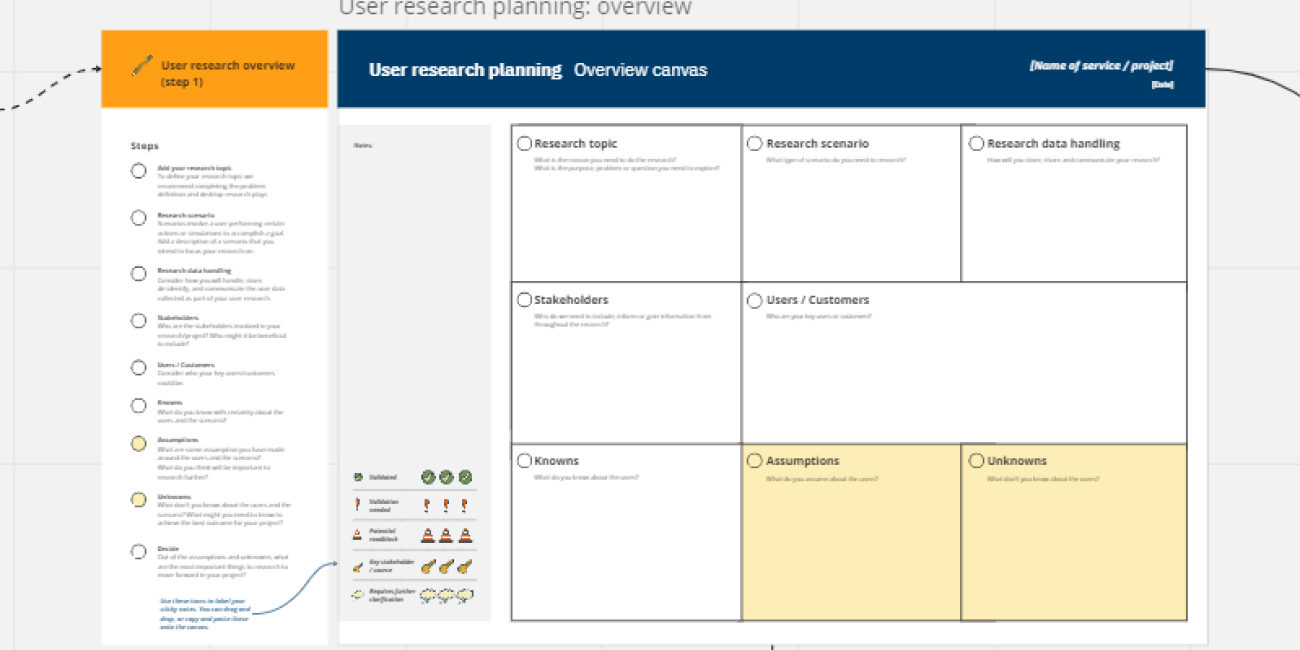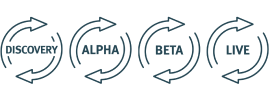User research planning
User research planning involves clarifying the details of your user research, identifying the appropriate research methods, and selecting the type of participants for the study.
By conducting user research planning early on, we can identify potential user needs, preferences, and pain points, as well as test assumptions and validate ideas. This can help save time and resources by identifying problems and addressing them before significant investments are made in design and development. Additionally, user research planning can help create a more focused and efficient research process, ensuring that research efforts are aligned with the project goals and objectives.
The best time to do user research planning in the Discovery stage of a project. This is because user research can inform design decisions and help ensure that the resulting product or service meets the needs and expectations of its intended users. However, as you develop hypotheses about user needs, you will have to revisit user research iteratively throughout the alpha, beta and live stages to ensure your solutions are effective for your users.

Outcomes
- Clear research objectives: User research planning helps in defining clear research objectives by identifying the research questions that need to be answered.
- Defined user segments: User research planning helps identify the user groups to target for the research. This helps ensure that the research is relevant and user-centred.
- Selected research methods: User research planning helps you select the most appropriate research methods for the defined artefacts you need for your project.
- Reduced risk: User research planning helps reduce the risk of creating products or services that do not meet user needs or expectations.
What you need
| Remote | In-person |
|---|---|
|
|
Instructions
Before starting your user research planning, we recommend doing the problem definition play and the desktop research play. By uncovering the problem and collecting existing research, you will have a better understanding of the problem, existing research and information around the topic, and users connected to it. That is a great starting point for doing user research planning.
Invite your participants
Calendar meeting request for user research planning
Subject:
Join us for a user research planning session for [project name]
Meeting description:
Hi [team name if sending a group invitation, or participant name if sending individual invitations]
As part of our work on [name of project], we’re looking to do some user research planning as part of the project.
The session will take about [x] minutes and there is no preparation required.
Having [you/each of you] attend will help to make sure we are including a diverse range of opinions and expertise in our project. [If conduction the session virtually include the following] We will be using Miro for this workshop].
If you would like some further insight into the activity you can read more on user research planning in the Digital service design playbook.
I look forward to your contribution to the session. [If you’re planning to record the session include the following - We will be recording the session for learning and development purposes and recordkeeping. Please let us know before the session if you don't want to be included in the recording or transcript].
The [project name] team is committed to inclusion for our events, and we appreciate the experience of inclusion is not the same for everyone. Please let us know what we can do to make our events more accessible and inclusive for you.
Kind Regards,
[Facilitator name]
Step 1 - Overview canvas
1. Add your research topic
Start with defining the research topic: What is the reason to perform the user research in the first place? This could be an identified problem or research area pulled from previously completed plays: problem definition and desktop research.
2. Describe the scenario
Scenarios involve a user performing certain actions or simulations to accomplish a goal. Add a description of a scenario that you intend to focus your research on.
3. Research data handling
Consider how you will handle, store, de-identify, and communicate the user data collected as part of your user research. If necessary, seek advice from the relevant information privacy team in your agency.
4. Stakeholders
Add all the people that will be useful throughout the research and the project. Also, include any core team members or people that you need to keep informed. You may have already identified your stakeholders in the Desktop Research play.
5. Identify your users
Add the target users here. Who is the user that is involved in the scenario? Who is it that you need to understand and research? You might have already defined this in the problem definition play.
6. Knowns: Collate what you already know
Add links and summaries of what you have collected so far. This could be links to other completed plays, or different resources you have found useful.
7. Assumptions: list your unvalidated assumptions
List all the assumptions you might have around the key users, the topic, and the scenario.
8. Unknowns: list any possible gaps and unknown areas
List all the possible gaps in understanding and knowledge about your research topic, users, and scenario. What are some key questions you might have? These will be very useful when deciding on what to explore further.
9. Decide
Out of the assumptions and unknowns, what is the most important thing to research?
Step 2 - Plan canvas
1. Research topic
Copy and paste your research topic from the overview canvas board.
2. Research focus
This is where you add any assumptions, unknowns, or questions that you need to explore further. This will be your guiding north star for this research plan.
3. Participants
Who do you need to participate in the research? Consider groups, communities and individuals that will be useful for your research.
4. Recruitment
How will you recruit participants for your research? What resources, groups, organisations, or programs could you draw on for recruitment?
5. Research team
Who will be undertaking the user research? You may need more than one person depending on the research methods used.
6. Timing
Are there any milestones, deadlines, or other time restrictions you need to work within? How could timing impact your research?
7. Potential artefacts
What are you hoping to produce from your research? Artefacts could include user interviews, opinions or feedback, personas, user flow, reports, systems diagrams, journey maps, etc.
8. Research methods
What research methods could you undertake to understand more about your users? How could these methods assist in developing your potential artefacts, or clarifying your unknown assumptions?
In this section, you can drag and drop research cards from below on the Miro board, or you can copy and paste if you are working on the Excel spreadsheet. These cards include links to sources and further information on the research methods.
Contact us if you need support in choosing or executing relevant research methods
Share your plan with the relevant stakeholders and core team, especially those who will be responsible for recruiting participants.
Resources
See below for a collection of templates and other pages which will help you run this play. These resources are also linked in the play instructions.
Subject:
Join us for a user research session for [project name]
Meeting description:
Hi [team name if sending a group invitation, or participant name if sending individual invitations]
As part of our work on [name of project], we’re looking to do some user research planning as part of the project.
The session will take about [x] minutes and there is no preparation required.
Having [you/each of you] attend will help to make sure we are including a diverse range of opinions and expertise in our project. [If conducting the session virtually include the following] We will be using Miro for this workshop].
If you would like some further insight into the activity you can read more on user research planning in the Digital service design playbook.
I look forward to your contribution to the session. [If you’re planning to record the session include the following - We will be recording the session for learning and development purposes and recordkeeping. Please let us know before the session if you don't want to be included in the recording or transcript].
The [project name] team is committed to inclusion for our events, and we appreciate the experience of inclusion is not the same for everyone. Please let us know what we can do to make our events more accessible and inclusive for you.
Kind Regards,
[Facilitator name]

